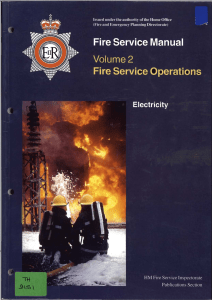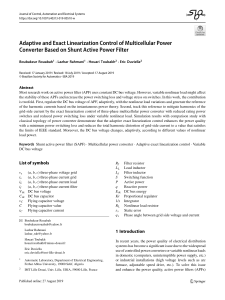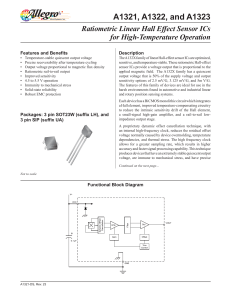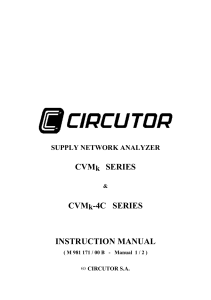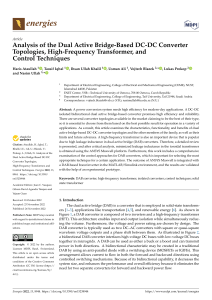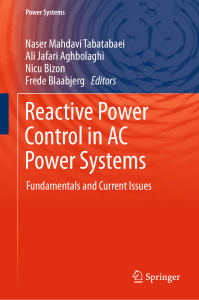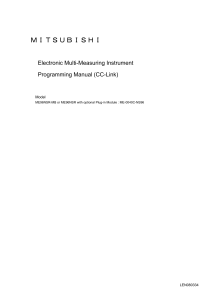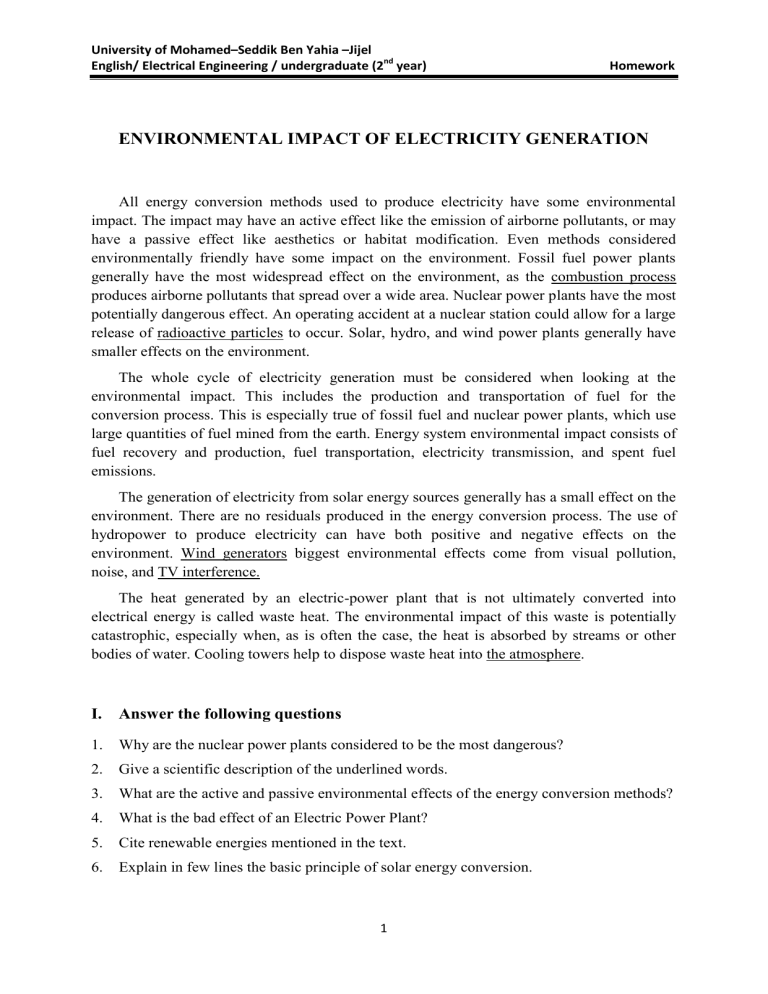
University of Mohamed–Seddik Ben Yahia –Jijel English/ Electrical Engineering / undergraduate (2nd year) Homework ENVIRONMENTAL IMPACT OF ELECTRICITY GENERATION All energy conversion methods used to produce electricity have some environmental impact. The impact may have an active effect like the emission of airborne pollutants, or may have a passive effect like aesthetics or habitat modification. Even methods considered environmentally friendly have some impact on the environment. Fossil fuel power plants generally have the most widespread effect on the environment, as the combustion process produces airborne pollutants that spread over a wide area. Nuclear power plants have the most potentially dangerous effect. An operating accident at a nuclear station could allow for a large release of radioactive particles to occur. Solar, hydro, and wind power plants generally have smaller effects on the environment. The whole cycle of electricity generation must be considered when looking at the environmental impact. This includes the production and transportation of fuel for the conversion process. This is especially true of fossil fuel and nuclear power plants, which use large quantities of fuel mined from the earth. Energy system environmental impact consists of fuel recovery and production, fuel transportation, electricity transmission, and spent fuel emissions. The generation of electricity from solar energy sources generally has a small effect on the environment. There are no residuals produced in the energy conversion process. The use of hydropower to produce electricity can have both positive and negative effects on the environment. Wind generators biggest environmental effects come from visual pollution, noise, and TV interference. The heat generated by an electric-power plant that is not ultimately converted into electrical energy is called waste heat. The environmental impact of this waste is potentially catastrophic, especially when, as is often the case, the heat is absorbed by streams or other bodies of water. Cooling towers help to dispose waste heat into the atmosphere. I. Answer the following questions 1. Why are the nuclear power plants considered to be the most dangerous? 2. Give a scientific description of the underlined words. 3. What are the active and passive environmental effects of the energy conversion methods? 4. What is the bad effect of an Electric Power Plant? 5. Cite renewable energies mentioned in the text. 6. Explain in few lines the basic principle of solar energy conversion. 1 University of Mohamed–Seddik Ben Yahia –Jijel English/ Electrical Engineering / undergraduate (2nd year) Homework II. Write : another, other, the other, others. 1. I met two strangers on the way to work. One of them greeted me and…………..didn’t . 2. Some people like to have the windows open all the time;…………….don’t. 3. I can't see him today. I'll have to see him ..……..…..day. 4. There must be …………... solution to solve the problem. 5. There must be.................... roads that lead to the city center. III. Complete the statements with the appropriate word. deplete – destroy – depletion –solve – destruction – depletable –demand– produce – depleted – destructive – solution – productivity 1. Ozone …………is the human destruction of the ozone layer. This can come from greenhouse gases, given off by factories, cars, and electricity usage. 2. Our supplies of food are rather ……………. If we continue to ……………. the Earth’s natural resources, we will cause serious damage to the environment. 3. Most energy resources currently in use are non-renewable. They are also called ………… resources. 4. Changes to water systems may increase the frequency and severity of……………floods. 5. The Tibetan plateau is at the stage of ecological ……………. due to extensive mineral extraction, deforestation and unscientific construction of highways and railways. 6. They………... an urgent review of the existing control system. 7. Various human activities threaten to disrupt the balance and…………. the world’s ecosystems. 8. We can ……………. our energy problems by learning how the world really works. 9. Technical progress remains the effective ……………… to the ecological threats such as global warming and pollution. 10. Increasing ………………… is one of the most critical goals in business. 11. Nuclear power plants can ………………a huge amount of power from a single unit. IV. Use the diagram, sentences and schematic diagram presenting different stages of electrical energy transmission to describe the transfer of electrical energy from generating power plants to electrical substations located near demand centers. A power plant produces electrical energy of medium (20.000 V) or low (1.000) voltage. A step-up substation elevates electrical power produced at a power generation plant to high voltage (up to 400 kV). 2 University of Mohamed–Seddik Ben Yahia –Jijel English/ Electrical Engineering / undergraduate (2nd year) Homework Electrical power is transmitted across long distances by high-tension power lines to reduce the energy losses. A step-down substation converts the high voltage back down medium voltage Most of the users are supplied with electrical power of low voltage, but bigger consumers can be directly supplied with the electrical power of medium voltage. Power plant Step-up substation High voltage over-Head lines Step-down substation Medium/ Low voltage transformer Users Step-up substation Transformer Subtransmission customer Transmission lines 765,500,345,230 Kv Gene rating station Step-up substation Transmission Custmer 138 or 230 Kv Transfer of electrical energy from generating power plants to electrical substations 3

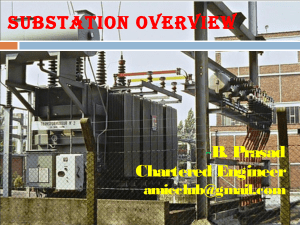
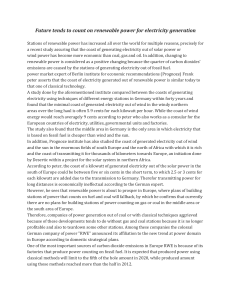

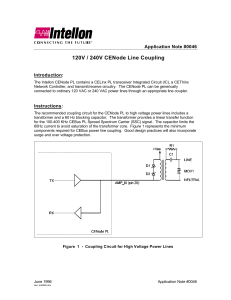

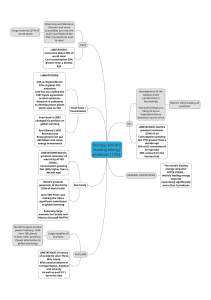
![mb+ Ignitio Coil'Autotransfo'[Pack'Module'], Diagnostic'Ignitio Coil'Test[Enlever Fuse:Relay'Fuel Pp']](http://s1.studylibfr.com/store/data/010155522_1-b3f163da05cefe71938d43d71eda4065-300x300.png)
